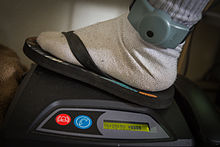Electronic tagging
form of surveillance; form of punishment outside of a prison but with restrictions of movement and with permanent surveillance
There are special electronic devices, that can be permanently attached to a person. These devices are called electronic tags. Using wireless or mobile phone networks, it is then possible to monitor where the person is, all the time. The device can also have extra functions, such as measuring certain parameters.


There are two basic use cases:
- People who have committed a crime can serve part or all of their sentence with an electronic tag. This is not available in all countries, and it is also not available for all crimes
- Certain people (mostly old people) have diseases or conditions where they often need help. Using such a device, it is possible to locate them easily.
Especially in the case of monitoring old people, there have been concerns about privacy.
In the case of monitoring a criminal or someone on probation, the person has to report to a base station at given times. When the base station no longer detects the signal from the tag, it will alert the authorities.